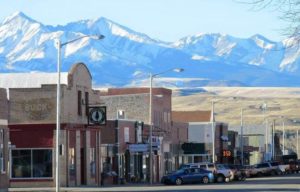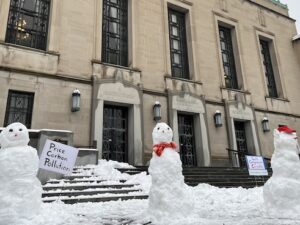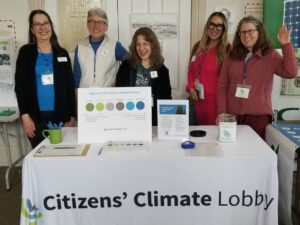By Alex Amonette
Evangelical Christian and climate scientist Dr. Katharine Hayhoe discusses how our fear of the impacts of climate change can lead to paralysis, despair, and denial of the problem. On her YouTube series Global Weirding, she says, “Feeling like we can be part of the fix is a much more effective way to change our minds about the reality of a problem than just yammering on endlessly about the problem.”
She adds, “One of the most important things to realize about climate change is how it will affect us in the places where we live. What we need to understand is both the problems we face and the ways we can fix them.”
That’s exactly what is going on in my 1,700-person town of Big Timber, Montana!
The Montana Climate Assessment presentation
In 2017, the “Montana Climate Assessment” was released. According to its website, the assessment is “an effort to synthesize, evaluate, and share credible and relevant scientific information about climate change in Montana” with its citizens.
Montana’s Sweet Grass County Chamber of Commerce (CoC) was interested. There were a few people who said they did not think the CoC should discuss this “controversial topic.” But our CoC members wanted to hear about it because (1) we want to know the risks to the town and our businesses; (2) we don’t want to be sitting ducks; we want a path forward to be resilient; and (3) we want to understand what’s causing it. And, as the CoC executive director said, “Our tax money went into this study, so why not take a look at the information?”
So in December 2017, the CoC hosted an excellent, well-attended presentation about the Montana Climate Assessment. Presenters from Montana State University Extension (MSU) and the Montana Institute on Ecosystems, along with the Montana Climate Office and Montana Water Center, authored the study. The local newspaper ran a front page article about the presentation. The Chamber of Commerce also posted the assessment on their website.
As MSU Extension Professor and community development specialist Paul Lachapelle said, “The first thing we need is for people to talk about this issue. Let’s put the pundits aside and look at the science…we encourage people to challenge the science.”
After the presentation
That’s what a farmer did after hearing the presentation.

The benefits of a longer growing season are cancelled by the dangers of drought and abnormally high temperatures.
Dave, who has raised Indian heirloom corn for 46 years, at first thought that a longer growing season, would be beneficial. (The growing season in his area is now 12 days longer than it was in 1950.) But as he dug further into the report’s findings, he realized, “I was mistaken thinking I could take advantage of a longer season,” partially because less snowpack means less water will be available. So, Dave says, “The new plan is to take advantage of the earlier spring and plant early, but select for small, faster-maturing plants that get their growth done before the July heat.”
The Assessment explains, “Days above 90 degrees are expected to increase most in the eastern part of the state; more 90-degree plus days will also increase evapotranspiration and water demand for most crops, limit grain development and elevate heat stress on livestock.”
Hopefully this assessment will help depoliticize the issue and build consensus that we need solutions. One Montana rancher said last year, “I really should side with scientists on climate change; however, the movement is so politically charged that I instead get skeptical.” In 2017, Montana suffered a devastating “flash” drought and wildfires that burned over 1M acres. One of our senators, Steve Daines (R-MT), said, “On the issue of climate change, one of the best carbon sinks is a healthy, robust forest. Think about all the carbon emitted in a raging wildfire versus the carbon that’s absorbed from a healthy, managed forest.”
Climate change impacts on Main Street

Big Timber, Montana. Photo by Saul Heinemann
In 2016, the Yellowstone River, which flows through the town, was closed to fishing, boating, and recreation due to the abnormally low flows, warm water temperatures, and a fish-killing parasite. The MT Fish and Wildlife Commissioner Dan Vermillion said, “It is our changing climate and, unless we act quickly, our ranching and tourism economy will suffer even greater losses in the future. It will take all of us – Republicans, Democrats, and independents to solve this problem. Future generations of Montanans are counting on all of us.”
Main Street suffered because, as one store owner and CoC member said of tourists, “When the husbands go fishing, the wives go shopping.” Our towns also depend on the agricultural community for business. If ranchers are not making “hay” and are selling underweight cattle, they don’t have the means to buy new clothes, go out to eat, or even go to a movie. Businesses lose business.
One rancher said, “If we don’t pull out of the drought by next spring [2018], my family and other ranchers will be in serious trouble because we’ve grazed all our available pasture. Many of us are doomed if we don’t get rain.”
Next steps
After the presentation, I suggested that one thing we can all do is to ask our representative, Greg Gianforte (R-MT), to join the bipartisan House Climate Solutions Caucus. We need all our representatives to help find economically beneficial solutions to stabilize our changing climate.
The CoC is now discussing: How can our town become resilient? Who can educate us? What renewable energy might be relevant and affordable?
One solution for a town’s electricity/storage is something like the 2-megawatt, 3.9-megawatt-hour battery storage system plus solar energy that provides the town of Sterling, Mass (pop. 8,000) with power, especially needed during severe weather events. It provides the town with peak power and backup power for the police/ambulance station. The peak power leveling part of the system saves the residents of the town $400K in utility bills annually.
I gave a presentation in June 2017 to the CoC on the Carbon Fee and Dividend, in my opinion, our best first-step policy solution that our government could enact this year to not only start stabilizing our climate, but create millions of jobs. The CFD is not a tax, I stressed, echoing former Secretary of State/Treasury, George Shultz. No one, me most of all, wants more taxes. I want an electric vehicle! I’d use my dividend to buy one.
People across our great country are discussing how we can all work together to stabilize our climate, create jobs and build resilient communities.
Together, we can find hope, joy, and millions of creative solutions to mitigate and adapt to our changing climate.






